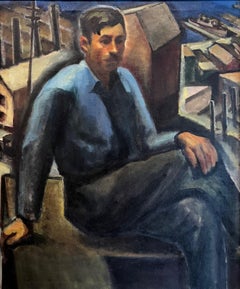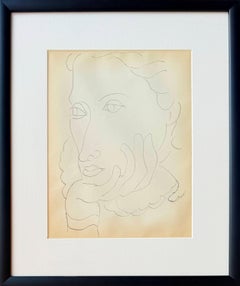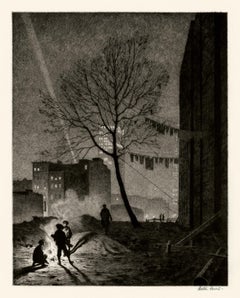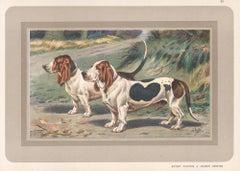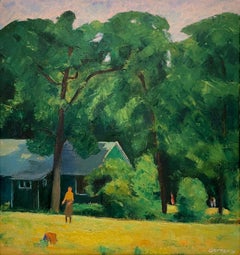1930s Art
to
817
3,408
1,188
903
521
344
Overall Width
to
Overall Height
to
7,550
21,292
159,182
232,435
1,972
2,246
4,944
6,412
5,826
13,332
19,802
25,693
18,303
13,590
5,389
2,458
488
379
227
127
114
102
71
12
12
5
2
2
3,503
2,393
312
3,836
1,720
1,619
1,139
1,098
708
451
439
439
362
356
317
288
287
275
251
227
220
213
195
2,016
1,531
1,361
1,156
865
261
105
88
83
61
1,747
1,137
3,330
2,674
Period: 1930s
Seated Female Nude Portrait - British 1930's portrait oil painting Empire frame
By Harold Knight
Located in Hagley, England
This superb British nude portrait oil painting is attributed to the circle of Harold Knight. Painted circa 1930, it is a seated study of a nude woman in soft focus, arms raised to on...
Category
Realist 1930s Art
Materials
Adhesive, Oil
$7,643 Sale Price
20% Off
A Laborer Resting
By Robert Gilbert
Located in Los Angeles, CA
A Laborer Resting, 1930, oil on canvas, signed and dated lower center, 36 x 30 inches, inscribed verso “July – 1930 / Title – A Laborer Resting / Artist – Robert Gilbert / Price - $2...
Category
American Modern 1930s Art
Materials
Canvas, Oil
Divagations
Located in OPOLE, PL
Henri Matisse (1869-1954) - Divagations
Photogravure from 1937.
Dimensions of work: 35.5 x 26.4 cm
Publisher: Tériade, Paris.
Text on the verso.
The work is in Excellent conditi...
Category
Surrealist 1930s Art
Materials
Photogravure
$659 Sale Price
20% Off
'Tree, Manhattan' — Classic American Realism
By Martin Lewis
Located in Myrtle Beach, SC
Martin Lewis, 'Tree, Manhattan', drypoint, 1930, edition 91 (including 10 trial proofs), McCarron 87. Signed in pencil. A superb, atmospheric impression, in warm black ink, on cream...
Category
American Realist 1930s Art
Materials
Drypoint
Bassets D'Artois a Jambes Droites, French hound dog chromolithograph print 1930s
By P. Mahler
Located in Melbourne, Victoria
'Bassets D'Artois a Jambes Droites'.
French chromolithograph, published in 1931. Signed by artist in the plate. Printed title lower right of sheet. Plate number top right. From a Fr...
Category
Art Deco 1930s Art
Materials
Lithograph
Rare & Special Painting by Important Chicago Modernist Artist Davenport Griffen
Located in Chicago, IL
A 1936 Modernist landscape painting with figures by important Chicago artist (William) Davenport Griffen. His paintings tend to be rare. Image size: 18" x 20". Framed size: 22" x 24".
(William) Davenport Griffen was born in 1894 in Millbrook, NY. He graduated from Iowa State College in Ames, IA in 1918 with a B.S. in Civil Engineering; however, Griffen’s true love was painting. In 1919, he enrolled in the Chicago Academy of Fine Arts and subsequently studied at the Art Institute of Chicago from 1923-1928. In 1926, he was awarded the American Travel Scholarship and began painting in Provincetown, MA. In 1928, he was awarded the John Quincy Adams Scholarship and spent six months painting in Paris, France. Griffen also painted in the U.S. Virgin Islands for 11 months between 1930-1931. Griffen had one-man exhibitions of his Virgin Islands paintings...
Category
American Modern 1930s Art
Materials
Oil, Canvas
“Trinity Church, Wall Street”
By Leon Dolice
Located in Southampton, NY
Original oil pastel on archival paper by the well known American artist, Leon Dolice. The painting depicts Trinity Church with several of the more contemporary buildings of Wall Stre...
Category
Modern 1930s Art
Materials
Oil Pastel, Archival Paper
Nearing the Peaks, Early 20th Century Mountainous Western Landscape
By Frank Wilcox
Located in Beachwood, OH
Frank Nelson Wilcox (American, 1887–1964)
Nearing the Peaks, 1937
Watercolor on paper
Signed and dated lower right
15 x 20 inches
18.5 x 24 inches framed
Frank Nelson Wilcox (Octo...
Category
American Modern 1930s Art
Materials
Watercolor
Paul Klee, Winter Sleep, from Verve, Revue Artistique, 1938
By Paul Klee
Located in Southampton, NY
This exquisite lithograph by Paul Klee (1879–1940), titled Sommeil d’hiver (Winter Sleep), from Verve, Revue Artistique et Litteraire, Vol. I, No. 3, originates from the 1938 issue p...
Category
Modern 1930s Art
Materials
Lithograph
$956 Sale Price
20% Off
Faraway Gaze from La Dame aux Camelias, Art Nouveau Etching after Louis Icart
By Louis Icart
Located in Long Island City, NY
Louis Icart, After, French (1888 - 1950) - Faraway Gaze from La Dame aux Camelias, Year: of original: 1938, Medium: Hand-Colored Etching, Image Size: 7.5 x 5 inches, Frame Size: ...
Category
Art Nouveau 1930s Art
Materials
Etching
"Charge of the Revolutionist Cavalry" - 1931 Woodcut On Paper
Located in Soquel, CA
"Charge of the Revolutionist Cavalry" - 1931 Woodcut On Paper
1931 Black and white woodcut print titled "Charge of the Revolutionist Cavalry" by Leo...
Category
Contemporary 1930s Art
Materials
India Ink, Laid Paper, Woodcut
A Very Finely Drawn 1930s Modern Figure Study, Standing Female Nude Model, Torso
Located in Chicago, IL
A Very Finely Drawn, 1930s Modern Figure Study of a Standing Female Nude Model (Torso) by Notable Chicago Modern Artist, Harold Haydon (Am. 1909-1994). An early charcoal drawing by...
Category
American Modern 1930s Art
Materials
Paper, Charcoal
Gstaad Switzerland - American impressionist 1930's art oil painting snow
Located in Hagley, England
This stunning Impressionist winter landscape oil painting is by one of the leading American Impressionism artists, William Samuel Horton. Horton moved to England in 1918 and travelle...
Category
American Impressionist 1930s Art
Materials
Oil
"Beach Landscape" Karl Fortess, WPA, Dramatic, Cloudy Sky, Beach, Dunes
Located in New York, NY
Karl Fortess
Beach Landscape
Signed lower left
Oil on canvas
8 x 10 inches
Karl Fortess was born in Belgium, moving United States and studying at the Art Institute of Chicago, the ...
Category
American Realist 1930s Art
Materials
Canvas, Oil
Bust of Josephine Baker, Mid-Century Ceramic Female Face
By Vally Wieselthier
Located in Beachwood, OH
Attributed to Vally Wieselthier (Austrian-American, 1895-1945)
Bust of Josephine Baker, c. 1930
Ceramic
Stamped on base
11.5 x 5.5 x 5.5 inches
Vally Wieselthier (1895 Vienna--1945 ...
Category
1930s Art
Materials
Ceramic
Icart, Composition, Le Sopha (after)
By Louis Icart
Located in Southampton, NY
La pointe sèche etching on vélin de Rives filigrané à notre nom paper. Paper size: 9.5 x 7.5 inches; image size: 6.5 x 4.5 inches. Inscription: unsigned and unnumbered, as issued. No...
Category
Modern 1930s Art
Materials
Drypoint, Etching
$876 Sale Price
20% Off
Pastel Portrait of Stella Samuel in the style of Charles Sheldon for Photoplay
Located in Pasadena, CA
The pastel portrait of Stella Samuel, very likely a starlet from the thirties, created in the style of Charles Sheldon, emanates timeless elegance. With a delicate interplay of color...
Category
Art Deco 1930s Art
Materials
Pastel
$520 Sale Price
56% Off
"Comets" original lithograph
Located in Henderson, NV
Medium: original lithograph. Printed in 1938 and published in Paris by Teriade for the art revue Verve (volume 1, number 2). Kandinsky was invited to contribute an original compositi...
Category
Expressionist 1930s Art
Materials
Lithograph
Industrial Mural Study, Veterans Memorial Building, Santa Barbara WPA American
Located in New York, NY
Industrial Mural Study, Veterans Memorial Building, Santa Barbara WPA American
Joseph Edward Knowles (1907-1980)
"Study for Industry Mural, Veterans Memorial Building, Santa Barbara, CA"
19 1/2 x 50 1/2 inches
Oil on board, c. 1930s.
Estate stamp verso
Framed: 27 x 60 inches
The completed mural is currently hanging on the wall, part of the building actually, at the Veterans Memorial Building in Santa Barbara. A photo of the work insitu is included in the attached photos.
BIO
Joseph Edward Knowles was born in Kendall, Montana, on June 15, 1907. He grew up in San Diego, California. At age twenty, two years before the beginning of the Great Depression, he moved north to another town on the coast of California---Santa Barbara. There he began studying fine art at the Santa Barbara School of the Arts* (1927-1930), under the supervision of Frank Morley Fletcher, previously director of the Edinburgh College of Art. Fletcher, who was trained in portraiture, landscape painting, and woodblock* printing, was a great influence on young Knowles. It was there that Knowles learned the art of color woodblock printmaking, a medium in which he showed great skill.
Not long after completing his studies with Fletcher, Knowles began teaching art. For a period of thirty years, from 1930 to1960, he taught at the Cate School in Carpinteria, California. In 1934-1935, Knowles traveled throughout Europe, further developing his artistic skills in England, France, and Italy. Upon his return, he continued to teach art at various schools and institutions: Cate School, Crane Country School, extension classes at the University of California at Santa Barbara (UCSB), and at the Santa Barbara Museum of Art (SBMA). Knowles also served as an art education consultant for the County of Santa Barbara. In addition, he was founding co-director and president of the Santa Barbara Fine Arts Institute (1969-1972), which later developed a specialization in photography and became the Brooks Institute of Photography. Knowles died at his home in Santa Barbara on September 8, 1980.
Much of Knowles' watercolor work is associated with what has been termed the "California School*," a loose grouping of artists throughout the state that included such figures as Millard Sheets, Phil Dike, Dong Kingman, George Post, and the Santa Barbara painters Dan Lutz and Standish Backus, Jr. The California School artists, including Knowles, were known for their fresh, direct, spontaneous style of watercolor painting. Knowles and other members of the school found inspiration in nature and the built environment alike, emphasizing elements of design in their exuberant, boldly stated, colorful scenes from everyday life. While painting in a representational* manner, Knowles generally avoided photographic realism, preferring subjective interpretation of his subjects. In this, as well as in his experimental approach and vigorous brushwork, he displayed a strongly modern sensibility.
Knowles often used the wet-on-wet watercolor technique as he painted seascapes and landscapes, mostly along the California coast. He also employed dry-brush* techniques in many of his paintings, often leaving some of the white of the watercolor paper exposed. Some of the latter depict trees and other forms in a broken and airy manner that recalls Cezanne.
Knowles' colored woodblock prints are more reserved and exact in their draftsmanship than his paintings. Spare, clean, lyrical lines are drawn to illustrate floral motifs and boat scenes with a touch of asymmetry conjuring Japanese woodblock prints. His murals from the post-World War II period are considerably more modern in their approach and show an emphasis on design and color.
PROFESSIONAL ORGANIZATIONS
California Watercolor Society (1940 - 1955)
Santa Barbara Art Association (Vice President - 1952)
ONE-MAN EXHIBITIONS
Golden Gate International Exposition (GGIE) - San Francisco, California
San Diego Fine Arts Gallery (SDMA) - San Diego, California
Santa Barbara Museum of Art (SBMA) - Santa Barbara, California
Cowie Galleries - Los Angeles, California
Gallery de Silva - Santa Barbara, California
Bradley Galleries - Santa Barbara, California
MURALS
Westmont College - Ellen Porter Hall Mural - Santa Barbara, California
Safeway Grocery (now Vons Grocery on West Victoria Street) - Exterior Tile Mosaic -
Santa Barbara, California
Santa Barbara Bank & Trust - Interior Mosaic Panels, Santa Barbara, California
Santa Barbara Girls Club - Interior Mosaic Mural - Santa Barbara, California
Ernest Righetti High School - Mosaic Mural - Santa Maria, California
Shell Oil Company - Mosaic Panel - California
Beckman Instruments, Corporate Headquarters - Mosaic - Fullerton, California
STAINED GLASS WINDOWS, WALLS and PANELS
Katherine Thayer Cate Memorial Chapel - Cate School, Carpinteria, California
William S. Porter Memorial Chapel - Cottage Hospital, Santa Barbara, California
La Rinconada Building - Santa Barbara, California
ILLUSTRATIONS
"California's Wonderful Corner: True Stories for Children from the History of the Santa Barbara Region," by Walter A. Tompkins (1962 & 1975)
China Designs:
Two sets of dinnerware for Winfield China...
Category
American Realist 1930s Art
Materials
Oil, Board
Squirrel - Woodcut by Maurits Cornelis Escher - 1931
Located in Roma, IT
Woodcut print realized by Escher in 1931.
It belongs to the series "Emblemata".
Signed with initials in the plate lower right.
Ref. F.H. Bool, J.R. Kist, J.L. Locher and F. Wierda...
Category
Modern 1930s Art
Materials
Woodcut
'Judgment of Souls' — Surrealist Fantasy
Located in Myrtle Beach, SC
Zena Kavin, 'Judgment of Souls', lithograph, c. 1935, edition 20. Signed, titled, and numbered '17/20' in pencil. A fine, richly-inked impression, on cream wove paper, with full marg...
Category
American Modern 1930s Art
Materials
Lithograph
Summer in the 1930s
Located in Cologne, DE
Summer in the 1930s
Captured in 1936 by German photographer Heinz Pollmann, this evocative image shows a young woman peacefully paddling across a lake in a classic Klepper folding k...
Category
Modern 1930s Art
Materials
Black and White
Portrait - Drawing by Mino Maccari - 1933
By Mino Maccari
Located in Roma, IT
Pencil drawing realized by Mino Maccari in 1933.
Hand signe "Mino" and daed 23/7/33..
Very good condition.
Category
Modern 1930s Art
Materials
Charcoal, Watercolor
French School Landscape Countryside
Located in Zofingen, AG
countryside scene from Rohlfs
⭐Signed:⭐ ROHLFS
⭐Medium:⭐ Oil on canvas
⭐Technique: ⭐Impasto painting with brushwork
⭐Size:⭐19x24cm / 7.48x9.44inch
⭐Date:⭐18/06/1936
⭐Condition ...
Category
Impressionist 1930s Art
Materials
Oil, Canvas, Stretcher Bars
Original Boyriven Aviation Navigation Chemin de Fer art deco vintage poster 1933
Located in Spokane, WA
An authentic, original Boyriven vintage poster designed by O.K. Gerand, professionally linen-backed for durability and display. A striking composition with bold graphics and clean ty...
Category
Art Deco 1930s Art
Materials
Lithograph
Vintage French Impressionist Signed Oil Pink & Yellow Roses in Vase
Located in Cirencester, Gloucestershire
Artist/ School: French Impressionist School, circa 1930's, indistinctly signed lower right corner
Title: Still life of roses in a vase (yellow, pink, reds)
Medium: oil on canvas, u...
Category
Impressionist 1930s Art
Materials
Oil, Canvas
Couple : The Argument - Original Lithograph
By Le Corbusier
Located in Paris, IDF
Le Corbusier (1887-1965)
Couple : The Argument, 1938
Original lithograph
Signature printed in the plate
Dated in the plate
On light vellum 21 x 27 cm (c. 8 x 11 inch)
Very good con...
Category
Modern 1930s Art
Materials
Lithograph
1932 original poster after A.M. Cassandre for Dubo Dubon Dubonnet
Located in PARIS, FR
The 1932 original poster after A.M. Cassandre for Dubo Dubon Dubonnet is one of the most iconic pieces of advertising art from the early 20th century. Designed by the renowned French artist Adolphe Mouron Cassandre, this poster is a striking example of modernist commercial design that revolutionized the way products were promoted in the 1930s. The playful, rhythmic slogan “Dubo Dubon Dubonnet” has become synonymous with the drink, elevating Dubonnet to a cultural symbol of France’s post-war glamour.
Dubonnet, originally created in 1846 as a medicinal tonic, was transformed into one of the most celebrated aperitifs in France by the time the 1932 poster...
Category
1930s Art
Materials
Linen, Paper, Lithograph
Icart, Sans titre, Le Sopha (after)
By Louis Icart
Located in Southampton, NY
La pointe sèche etching on vélin de Rives filigrané à notre nom paper. Paper size: 9.5 x 7.5 inches; image size: 6.5 x 4.5 inches. Inscription: unsigned and unnumbered, as issued. No...
Category
Modern 1930s Art
Materials
Drypoint, Etching
$876 Sale Price
20% Off
Cinésias et sa famille (Bloch 267-272; Cramer 24), Lysistrata, Pablo Picasso
Located in Southampton, NY
Etching on vélin de Rives BFK paper. Paper Size: 11.5 x 9 inches. Inscription: Unsigned and unnumbered, as issued. Notes: From the album, Lysistrata, 1934. Published by The Limited E...
Category
Cubist 1930s Art
Materials
Etching
$11,596 Sale Price
20% Off
"Georgia Moonshiner, c. 1935" by Athos Menaboni (1895-1990) American WPA Era Oil
Located in Yardley, PA
A fantastic WPA-era painting of a Georgia moonshiner by famed Italian-American artist Athos Menaboni (1895-1990).
This work depicts an older man sporting a brown hat, brown jacket, ...
Category
American Modern 1930s Art
Materials
Masonite, Oil
Original Visitez Les Aquariums Mosans vintage poster
Located in Spokane, WA
"Original Vintage Aquariums Mosans Poster – Art Deco Design by A. de Loof, 1930s European Travel Advertising"
Discover the Captivating "Moselle Aquariums" - A Vintage Poster by A. d...
Category
Art Deco 1930s Art
Materials
Lithograph
Wild Duck, French antique natural history bird duck art illustration print
By P. Mahler
Located in Melbourne, Victoria
'Canard Sauvage'
(Wild Duck)
French chromolithograph, published in 1931. Printed title lower right of sheet. Plate number top right. From a French series of illustrations of birds....
Category
Art Deco 1930s Art
Materials
Lithograph
On the Beach (Coney Island, New York) — 1930s Graphic Modernism, WPA
By Lou Barlow
Located in Myrtle Beach, SC
Lou Barlow (Louis Breslow), 'On the Beach' (Coney Island) wood engraving, c. 1937, edition c. 25. Signed and titled in pencil. Stamped 'FEDERAL ART PROJECT NYC WPA' in the bottom left margin. A fine, richly-inked impression, with all the fine lines printing clearly, on cream wove paper, with full margins (1 1/2 to 3 inches), in excellent condition. Matted to museum standards, unframed. Scarce.
Image size 11 x 8 1/8 inches; sheet size 16 x 11 3/8 inches.
Created during the Great Depression for the Works Progress Administration (WPA), Federal Art Project, New York City.
Impressions of this work are in the permanent collections of the Amon Carter Museum of Art, Illinois State Museum, and the New York Public Library.
ABOUT THE IMAGE
Due to Coney Island's proximity to Manhattan, Brooklyn, and other New York boroughs, it began attracting vacationers in the 1830s and 1840s. Most of the vacationers were wealthy and went by carriage roads and steamship services that reduced travel time from a formerly half-day journey to two hours. By the late 1870s, the development of Coney Island's amusement park attractions and hotels drew people from all social classes. When the Brooklyn Rapid Transit Company electrified the steam railroads and connected Brooklyn to Manhattan via the Brooklyn Bridge at the beginning of the 20th century, Coney Island turned rapidly from a resort to an accessible location for day-trippers seeking to escape the summer heat in New York City's tenements. In 1915, the Sea Beach Line was upgraded to a subway line, and the opening of the Stillwell Avenue station in 1919 ushered in Coney Island's busiest era. On the peak summer days, over a million people would travel to Coney Island. In 1937, New York City purchased a 400-foot-wide strip of land along the shoreline to allow the boardwalk to be moved 300 feet inland. At this point, Coney Island was so crowded on summer weekends that parks commissioner Robert Moses...
Category
American Modern 1930s Art
Materials
Woodcut
Frida and Diego with Gas Mask - Mexican Artists, Couple, Painter, Kahlo, Rivera
Located in Denton, TX
Frida and Diego with Gas Mask is a limited edition black and white portrait of Mexican painters Frida Kahlo and Diego Rivera. The couple embraces each other while Frida holds a gas m...
Category
Modern 1930s Art
Materials
Archival Pigment
"Jeune fille dans une barque" lithograph
Located in Henderson, NV
Medium: lithograph (after the watercolor). Printed in 1939 at the Mourlot Frères atelier for the art revue Verve and published in Paris by Teriade. Size: 14 x 10 1/4 inches (355 x 26...
Category
Fauvist 1930s Art
Materials
Lithograph
"New York Harbor (Brooklyn Bridge)" Leon Dolice, Mid-Century New York Nocturne
By Leon Dolice
Located in New York, NY
Leon Dolice
New York Harbor (Brooklyn Bridge), circa 1939-1940
Signed lower left
Pastel on paper
12 x 19 inches
Exhibited
Roslyn Harbor, New York, Nassau County Museum of Art, Deco ...
Category
American Modern 1930s Art
Materials
Paper, Pastel
Daphnes and Chloé, Planche XLI
By Marc Chagall
Located in OPOLE, PL
Marc Chagall (1887-1985) - Daphnes and Chloé, Planche XLI
Lithograph from 1961.
Dimensions of work: 43 x 66 cm.
Enhanced with gouache. Examined and identified by a French gallery ...
Category
Symbolist 1930s Art
Materials
Lithograph
The Jester, Post Cover
Located in Fort Washington, PA
Signed by Artist Lower Right
The Saturday Evening Post, February 11, 1939, cover illustration
Literature
The Saturday Evening Post, February 11, 1939, cover illustration
Thomas S....
Category
1930s Art
Materials
Oil
Brunelleschi, Composition, La Leçon d'amour dans un parc (after)
Located in Southampton, NY
Lithograph and stencil on vélin d’Arches paper. Unsigned and unnumbered, as issued. Good condition. Notes: From the volume, La Leçon d'amour dans un parc, 1933. Published by Éditions...
Category
Modern 1930s Art
Materials
Lithograph, Stencil
$1,436 Sale Price
20% Off
Return from the Tiger hunt
Located in PARIS, FR
"Return from the Hunt"
also named '"Return from the Tiger hunt"
by Roger GODCHAUX (1878-1958)
Remarkable bronze group with a nuanced dark greenish brown patina
Signed on the base "...
Category
Art Deco 1930s Art
Materials
Bronze
A Cheerful, 1930s American Scene Landscape Painting with Church and Country Road
Located in Chicago, IL
A Cheerful, 1930s American Scene Landscape Painting with Church and Country Road by Notable Chicago Modern Artist, Francis Chapin (Am. 1899-1965). A gem of a painting, exemplifying ...
Category
American Modern 1930s Art
Materials
Canvas, Oil, Board
Antique American Impressionist Signed Coastal Seascape Wide Gold Framed Painting
Located in Buffalo, NY
Antique American impressionist coastal seascape oil painting. Oil on canvas. Signed. Framed. Measuring 30 by 36 inches overall and 24 by 30 painting alone.
Category
Impressionist 1930s Art
Materials
Canvas, Oil
Spanish landscape oil on board painting
Located in Sitges, Barcelona
Josep Ventosa Domenech (1897-1982) - Navarcles - Oil on panel
Oil measurements 16x22 cm.
Frame measurements 31x37 cm.
Category
Impressionist 1930s Art
Materials
Oil, Board
$597 Sale Price
37% Off
Death is something like Cousin Cynthia (Spies/Leppien 13 IV), Max Ernst
By Max Ernst
Located in Southampton, NY
Photogram from a frottage in black in white on photosensitive paper. Inscription: Unsigned and unnumbered, as issued. Good Condition; never framed or matted. Notes: A photogram was a...
Category
Surrealist 1930s Art
Materials
Photogram
$1,116 Sale Price
37% Off
The Lonely Tower
Located in New Orleans, LA
This is a fine aquatint etching by British artist Percival Gaskell. The title is: The Lonely Tower, Roman Campagna, it was created and printed in 1924 in an edition of 150. The ima...
Category
English School 1930s Art
Materials
Aquatint
$280 Sale Price
20% Off
Place de la République, 20th Century Oil on Canvas by Edouard Léon Cortès
Located in Madrid, ES
EDOUARD LÉON CORTÈS
French, 1882 - 1969
PLACE DE LA RÉPUBLIQUE
signed "EDOUARD CORTÈS." (lower right)
oil on canvas
25-3/4 x 36-1/4 inches (65 x 91.5 cm.)
framed: 33-1/2 x 44-1/4 inches (85 x 112 cm.)
PROVENANCE
Private Collection, Chicago
Edouard Léon Cortès (1882–1969) was a French post-impressionist artist of French and Spanish ancestry. He is known as "Le Poète Parisien de la Peinture" or "the Parisian Poet of Painting...
Category
Post-Impressionist 1930s Art
Materials
Oil, Canvas
Repose
By Louis Icart
Located in PARIS, FR
Repose
by Louis ICART (1888-1950)
Old genuine Lithograph
Signed « Louis Icart ».
With the mention « copyright 1934 by L. Icart Sty. N.Y. »
France
1934
measurements : 119 x 52 cm
fr...
Category
French School 1930s Art
Materials
Lithograph
$7,762
Gloucester Harbor Antique American Oil Painting Fishing Boat Framed 1930
Located in Buffalo, NY
A gorgeous American impressionist painting of Gloucester Harbor.
Unsigned but by a very skilled hand.
The canvas is 20" x 16" housed in a period frame.
Category
Impressionist 1930s Art
Materials
Oil, Board
$951 Sale Price
20% Off
" Sunlit Mountains" Majestic Mount Jefferson And Mount Hood Oregon 1930s
By Andrew Dobos
Located in Soquel, CA
" Sunlit Mountains" Majestic Mount Jefferson And Mount Hood Oregon 1930s
A well executed oil on linen of two mountain peaks by California and Illinois artist Andrew Dobos (American/P...
Category
American Impressionist 1930s Art
Materials
Linen, Oil
"Hay Bales in Front of a Church" Piet Lippens (Belgian, 1890-1981)
Located in SANTA FE, NM
Dutch Landscape "HayBales in Front of a Church"
Piet Lippens (Belgian, 1890-1981)
Circa 1930s
Oil on canvas, signed lower right
19 1/2 x 23 1/4 (24 1/4 x 28 1/4 frame) inches
Piet ...
Category
Dutch School 1930s Art
Materials
Canvas, Oil
Portrait of Woman - Painting by Antonio Feltrinelli- 1930s
Located in Roma, IT
Portrait of woman is an orignal modern artwork realized by Antonio Feltrinelli in 1930s.
Mixed colored oil painting on wooden panel.
Not signed.
Very Good conditions
Antonio Fel...
Category
Modern 1930s Art
Materials
Paint, Oil, Wood Panel
Tramway Lines in Lyon, France 1930, Silver Gelatin Black and White Photography
By Press Photo
Located in Atlanta, GA
Original Silver Gelatin Print Photography.
Press Photography.
Title: Street view in Lyon, France, circa 1930.
Provenance: Private collection.
Image Size: 4.89 in high (11.4 cm) x...
Category
Art Deco 1930s Art
Materials
Silver Gelatin
Untitled (Joe Louis knocking out Max Schmeling in 1938 rematch)
Located in Fairlawn, OH
Untitled
(Joe Louis knocking out Max Schmeling in 1938 rematch)
Pen and ink with wash on heavy wove sketchbook paper, 1938
Signed lower right: Fletcher Martin
Directly related to Martin's famous painting of 1942 entitled "Lullaby", which was also used in the lithograph of the same name. (see photo)
The drawing depicts the third and final knockdown of Max Schmeling in their rematch of 1938.
Condition: Mat staining at the edges of the sketchbook page edges
Toning to verso from previous framing.
Does not affect framed presentation
"It was here that Louis first used sport to bridge America's cavernous racial divide. With Hitler on the march in Europe and using Schmeling's victory over Louis as proof of “Aryan supremacy,” anti-Nazi sentiment ran high in the States. Louis had long grown accustomed to the pressures of representing his race but here the burdens were broader and deeper. Now he was shouldering the hopes of an entire nation.
A few weeks before the match Louis visited the White House and U.S. President Franklin Delano Roosevelt, whose tenure lasted even longer than Louis' would, told him, “Joe, we need muscles like yours to beat Germany.”
Those muscles certainly beat Schmeling on fight night...
Category
American Realist 1930s Art
Materials
Ink
Icart, Sans titre, Le Sopha (after)
By Louis Icart
Located in Southampton, NY
La pointe sèche etching on vélin de Rives filigrané à notre nom paper. Paper size: 9.5 x 7.5 inches; image size: 6.5 x 4.5 inches. Inscription: unsigned and unnumbered, as issued. No...
Category
Modern 1930s Art
Materials
Drypoint, Etching
$876 Sale Price
20% Off
Circus Bareback Rider, Original cover for The Saturday Evening Post, 1932
Located in Fort Washington, PA
Original cover for The Saturday Evening Post magazine, published May 14, 1932
Joseph Christian Leyendecker’s Circus Bareback Rider (1932) is a standout example of his work for The S...
Category
1930s Art
Materials
Canvas, Oil
'Seated Nude', Paris, Académie Chaumière, Salon D'Automne, LACMA, Woman Sculptor
By Caroline Lloyd
Located in Santa Cruz, CA
Signed 'Lloyd' for Caroline Lloyd (American, 1875-1945), created circa 1935 and impressed with foundry stamp, 'C. Valsuani Cire Perdue', for Claude Valsuani Fonderie, Paris.
Please...
Category
1930s Art
Materials
Bronze
"Le Pont-Neuf" original etching
By André Derain
Located in Henderson, NV
Medium: original etching. This impression on Canson et Montgolfier wove paper was printed in 1937 in an edition of 500 for the "Paris 1937" portfolio. Printed at the atelier of Jean-...
Category
1930s Art
Materials
Etching
Neon Lighting WPA Mid 20th Century Social Realism American Scene Modern Figures
Located in New York, NY
Neon Lighting WPA Mid 20th Century Social Realism American Scene Modern Figures
MAURICE BECKER (1889-1975)
'Neon Lighting
17 1/4 x 13 3/4 inches
Oil on masonite
Signed, dated 1936 and titled on verso
BIO
Maurice Becker, painter, political cartoonist and social reformer, was born in 1889 either in Gorky or Niznij Novgorod, in Russia. His family came to the United States in 1892, to New York City. After high school, Becker worked in a clothing factory. He studied with Ash Can School artist Robert Henri in 1908, and exhibited in the famous 1913 Armory Show in New York City when he was only twenty-four years of age.
At the Armory show, Becker showed a drawing of a dog's head...
Category
American Modern 1930s Art
Materials
Masonite, Oil
Icart, Sans titre, Le Sopha (after)
By Louis Icart
Located in Southampton, NY
La pointe sèche etching on vélin de Rives filigrané à notre nom paper. Paper size: 9.5 x 7.5 inches; image size: 6.5 x 4.5 inches. Inscription: unsigned and unnumbered, as issued. No...
Category
Modern 1930s Art
Materials
Drypoint, Etching
$876 Sale Price
20% Off

